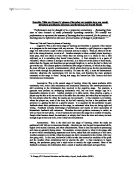Associative (intermediate) phase
The learner now understands the aim of the activity. The movement patterns are now becoming more fluent and integrated. Simple aspects of the movement that is being learned is becoming well learned and there is scope to refine the more complex aspects of the skill be learned. In this stage the aim for the learner is to begin to associate himself/herself with the feel of the movements with the end results. Although it is a step up form the cognitive phase it is still important to give feedback, but this time you must be more specific e.g. when you kick the ball high and far you must lean back and strike the ball with the laces. Instead of try and get underneath the ball. Feedback should also focus o both knowledge of results and knowledge of performance, this is to allow the association of kinaesthetic feedback with outcomes.
Autonomous (final) phase.
The performer who is in this stage should now have well integrated movement patterns and this should become automatic, they can perform the skill without giving any conscious attention to the movement, unless it is required. This will now give him more time to concentrate on the surroundings around him and example of this is a tennis player can use the opponent’s wrist and racquet action to judge the type of spin being put on the ball, this would be to difficult for a novice or in this case a cognitive learner as there is too much to think about. In this phase there is a lot less feedback than the other two phases, this is because they should be able to judge what their errors are and how they are performing. Any information feedback can now be very detailed and specific.
Practise can be structured to allow performers to progress through the stages, by using Fitts and Posner’s learning theory. For example a basketball lay up shot.
A cognitive learner will need to be shown how to hold the ball first, when performing a basketball lay up shot. Then the coach will show them what it should like once you have practised. Once he has shown them what it should look like, he will break it down in stages. First he will show them where abouts on the backboard you should aim your ball at. He will give lots of feedback to help the performer learn and gain encouragement, also give a few more demonstrations of where to aim the ball at on the backboard. Once positive reinforcement has been done of where to aim the ball, he will be able to move on. This time he will show them, what the correct footwork is, he will place two hoops down, and say these are your steps before you have to put the ball in the basket, otherwise it is a foul. He will show them how to do it first without bouncing the ball and ask them to do it, if done well he may give them feedback or wait until the next phase of the basketball lay up, this is when they can bounce the ball while going to the basket, he will advise them to walk through it for the first couple of times a running or a slow jog might be to difficult for them, once they become more confident with encouragement he is given them and feedback they will begin to run with the ball and make it almost look like a basketball lay up. An associative performer will have the basic skills to produce a basketball lay up but this time he will be more aware of what is going on around, this could mean that because he is better with his awareness he doesn’t have to look at the ball while bouncing it and instead look up, also the coach will work on his awareness by putting in a passive defender, just make it a little obstacle for the performer which will help in the game situation. The feedback given in this phase can be a little more specific to the task, although the performer has the general basis to the basketball lay up there still will be many errors, but not as much as the cognitive learner. An autonomous performer will be very well adapted to the basketball lay up. The performer will be able to perform the skill without putting any conscious thought into what he is doing, this performer is well developed an able to give his own feedback on how he is performing and the coach if need to give any feedback that the performer cannot spot, can be very detailed and specific.
The references I have used are: Class notes and Davis et al “Physical Education and the study of sport” Forth Edition.







